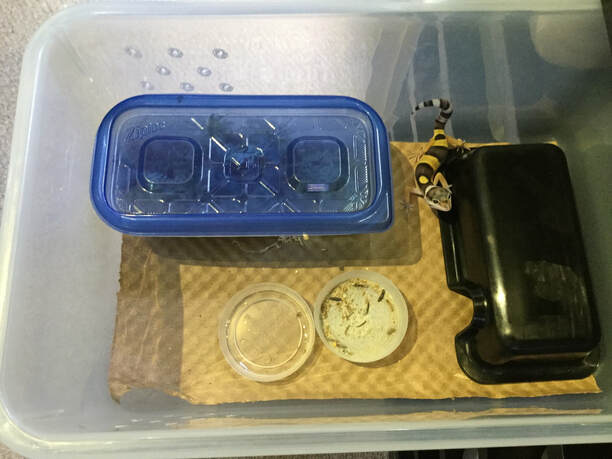
When you buy an animal, it is familiar only with the environment in which it has been raised. Sudden shifts in surroundings and diet can be very stressful for the animal, contributing to feeding, health, and behavior problems. This short guide is intended to illustrate how your new animal has been cared for prior to you coming to care for it. I’ll also give some limited suggestions for long term care, but since our collective knowledge of best care practices are constantly improving, and because what works well for one keeper may be less than ideal for another, seeking out reliable care information is your ongoing responsibility.
I keep hatchling leopard geckos alone in 6 quart shoeboxes (6” x 12” x 4” high) in a solid sided rack system. The back 1/3 of the enclosure is thermostatically controlled to 92 degrees F at the substrate. The cool side remains about 75 degrees. I use newspaper or textured kraft paper for substrate, though I have used Eco Earth (coco coir) with good results.
On the hot spot is a small Reptile Basics hide (3” x 5”). On the cool side is a 3” x 5” plastic food storage container half full of moist sphagnum moss for the gecko to retreat to when shedding.
Every three days the gecko is given 8-10 appropriately sized superworms or dubia roaches, heavily dusted with Repashy Calcium Plus. Superworms are more active than mealworms and have always resulted in a stronger feeding response in my experience. Periodically (every 3-4 weeks or so) the gecko is offered 3-4 appropriately sized dusted crickets. The rare problematic feeder is offered phoenix worms, waxworms, or very small hornworms. The gecko always has access to a small bowl of fresh water.
At about 25 grams, the gecko is moved to a larger enclosure, usually a split 28 quart tub, giving the gecko an enclosure of 6” x 24” x 5” high. Again, the back 1/3 of the enclosure is heated to 92 degrees at the substrate. The same cage furnishings and foods are supplied, though often geckos at this size will have slowed down somewhat on their food intake, eating only about 2 prey items each day on average. If they eat more, though, I feed them more.
I will sometimes cohabitate subadult leopard geckos, keeping up to three subadult females in a 28 quart tub (16” x 24” x 5” high). This sometimes results in increased seclusion, reduced feeding, and — rarely — fatal aggression. When cohabitating, I always have extra enclosures ready for immediate separation of any animal showing signs of stress. Leopard geckos are not social, do not 'bond', and ideally are housed alone.
Note that this housing scheme provides cozy, warm, secure, and relatively dark surroundings. I’ve found that leopard geckos thrive under these conditions.